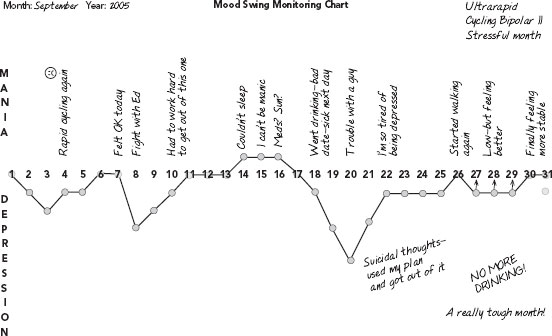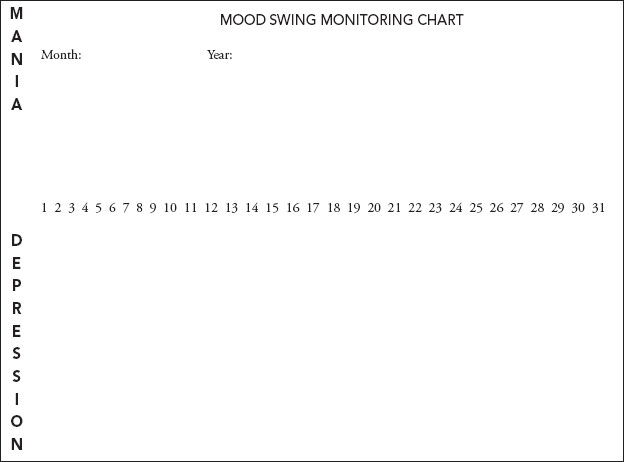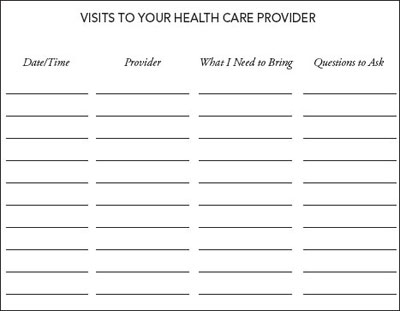
CHARTS AND JOURNAL PAGES

Make copies of this chart and fill in all the pertinent information on a separate sheet for each health care provider on your team.
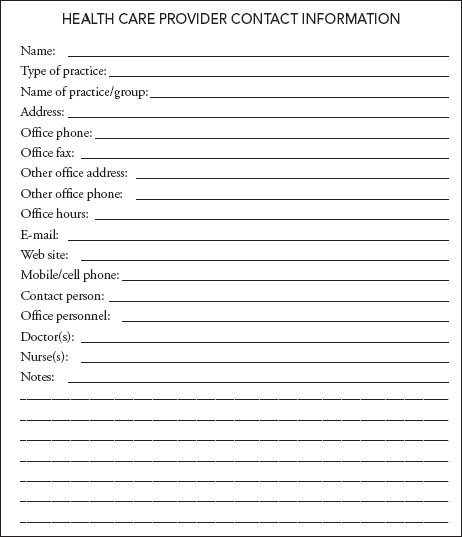
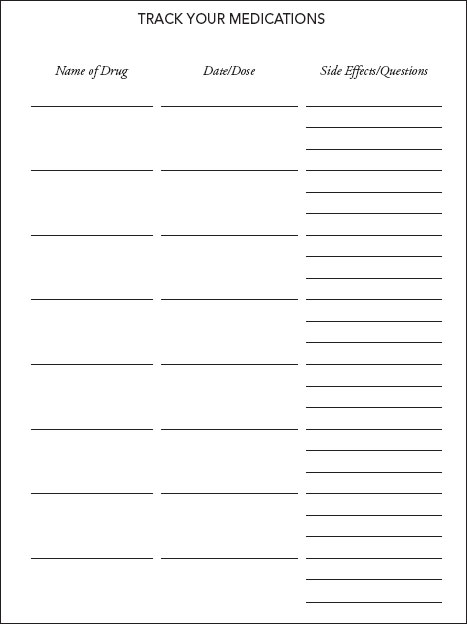
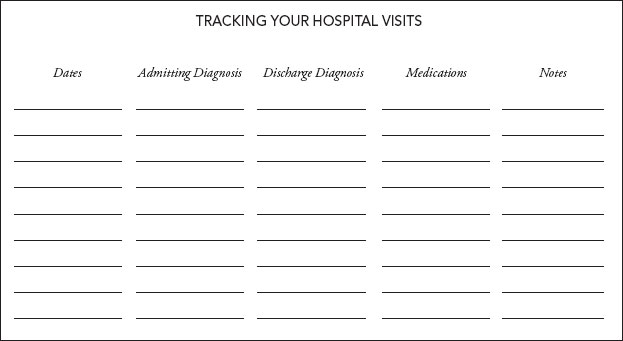
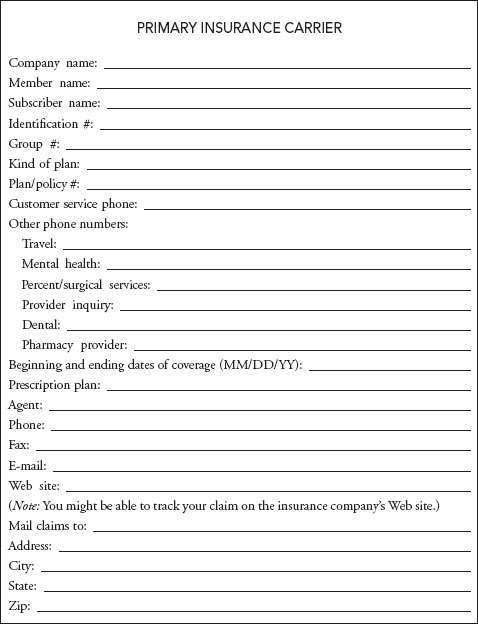
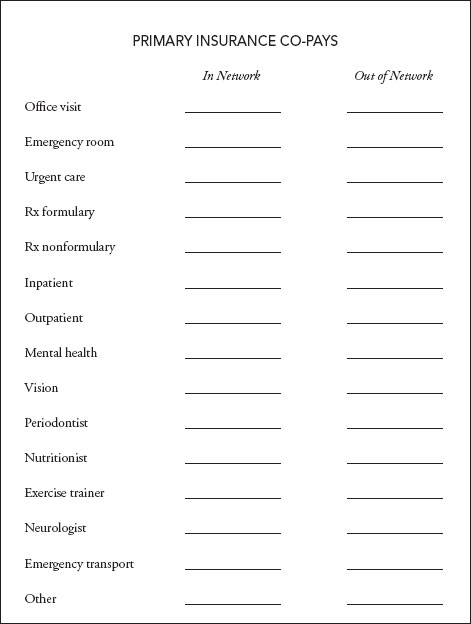
YOUR BIPOLAR DISORDER JOURNAL
You can begin using this journal system at any time. Once you’ve made copies of the pages provided and found a good system for keeping them together, fill in the dates, beginning with the date you start using the journal. These journal pages will help you to track your moods, and provide a space for you to use the ideas offered in this book.
The first goal when you start the journal is to look over the week and then list any bipolar-disorder-related appointments you may have. If there is a particular topic you want to cover in the appointment, write it under the time, and take your copied pages with you as a reminder to ask the questions you want answered. You can also make a list of any paperwork you need to get ready. There is a to-do list at the beginning of each week, where you can write any bipolar-disorder-related tasks you need to accomplish for the week, such as making an appointment, refilling a prescription, or asking for help. You will also notice that each day of the week asks you to look at a particular element in managing bipolar disorder.
At the end of each week is a place for you to think ahead regarding any possible triggers in the week you may need to prepare for. Think about travel, a work/school obligation, a social event, or any other change that may cause mood swings if you aren’t prepared.
You may also want a separate journal that you use for writing your feelings and experiences in more detail. A journal can be a friend and confidant when the illness needs more help than the people around you can provide.
Sample Journal Pages
To do: Week of 01/01 to 01/07
Call social worker, get antidepressant refilled. New antipsychotic? Look into gym? Review Take Charge chapters. Call about the hospital bills.
Monday, 01/01 (On a scale of 1-10, how is my mood?)
I’m not feeling too well today. I need more help than I’m getting. I’m going to try the tips in this book. I have to get better. I can’t live like this anymore. My mood is a 3. I want to feel normal again. It’s hard to get things done.
Tuesday, 01/02 (Are my medications working?)
Therapist 1 PM. I will talk with her about these medications. It just seems like I have to take so many drugs. How can I accept this? I just want to stop everything. I now know this is a sign that I need help. I will talk with Dr. J about the meds on Friday.
Wednesday, 01/03 (How is my spending going this week?)
I’m worried about money. I can tell that I’m spending to feel better when I’m down. I’m worried about rent and need to talk to my social worker about getting some assistance. I missed so much work when I was in the hospital. It feels like I’ll never recover.
Thursday, 01/04 (Am I eating a bipolar-friendly diet?)
I’m trying! It’s so hard when I feel so tired. I crave junk to get some energy. I am going to use the ideas in chapter 2 to make some changes. I have to remember that just one change is enough for now.
Friday, 01/05 (How is my exercise this week?)
Dr. J, 3 PM. Ask about meds, weight gain, and if she knows a self-help group I can go to. We may try a new antidepressant.
I actually walked in the sun this morning and it really helped. I’m going to ask people to walk with me. I walk farther and it really helps my mood if I’m with a friend. I tried to remind myself about the serotonin and why I need to walk and move my arms and get sun in my eyes.
Saturday, 01/06 (What can I do for fun today?)
I had a great morning. I’m finally feeling better. I pray it isn’t mania. How do I know? I need to list my mania symptoms so that I can tell the difference between the real me and mania. I’m having tea with a friend for fun today. I’ll try not to talk too much.
Sunday, 01/07 (How was my sleep this week?)
I’m sleeping less. I know this is a sign. I can’t get manic again. I just can’t. I will try to sleep more tonight. Do I need to call Dr. J? I will see how much I sleep tonight. Could the new medication do this already?
Possible triggers this week: There’s a new person at work. This is stressful for me. The days are dark in the afternoon. I’m running out of money. My mother comes to visit in a few weeks and we always argue. What can I do now to make sure I don’t get sick this time?
You can make copies of the following pages to make sure you have enough for a few months.
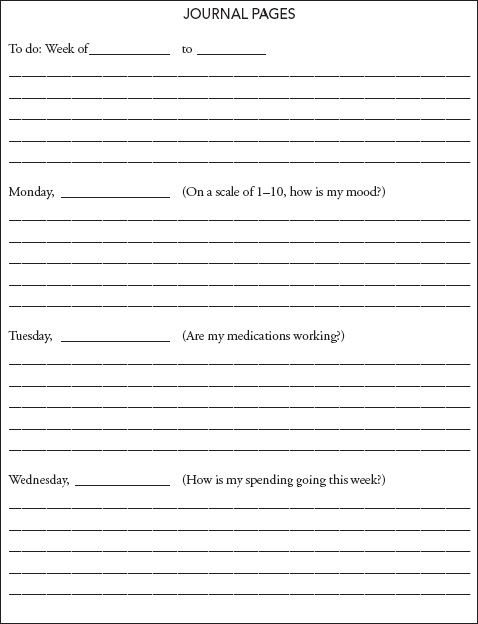
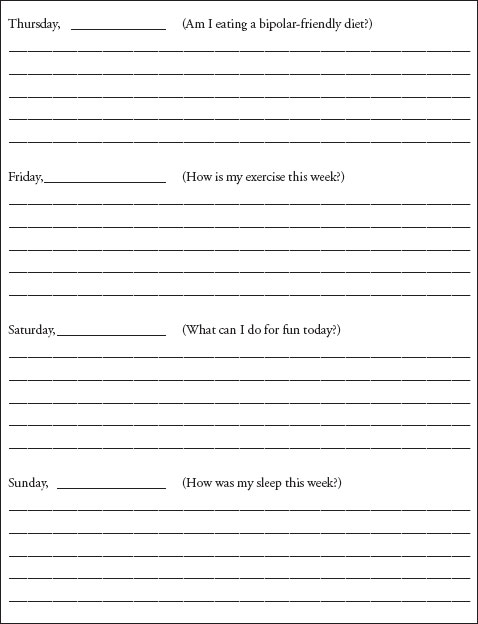
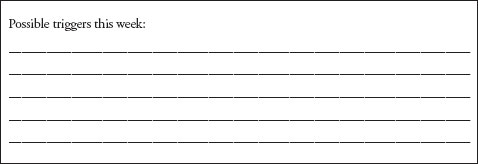
MOOD SWING MONITORING CHART
The chart on page 280 can help you to see patterns in your mood swings. Make copies so that you have a chart for each month. If you notice a big change in your moods as you keep this chart, write the trigger next to the change so that you can avoid the trigger in the future. If you’re a woman, also note your menstrual cycle. If you have trouble with anger and aggression, look for a pattern. If you seem to get depressed at certain times of the day, note this in the chart. You can also write down when you start or stop a medication so that you can see the results. Put a dot on the graph to represent your mood each day. Dots on the line mean that you are feeling normal; dots below represent depression, while dots above indicate mania. Make sure that you note any of the other major bipolar disorder symptoms you are experiencing, such as psychosis or anxiety, as well. At the end of the month, you can then connect the dots for a graph of your moods. Opposite, is an example of a mood swing chart for ultrarapid cycling Bipolar II.
